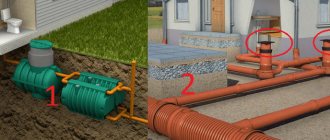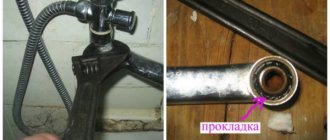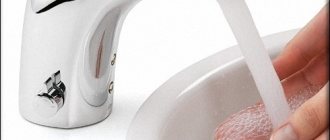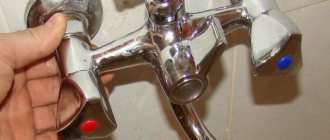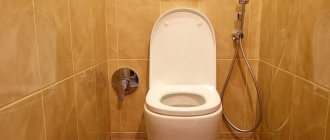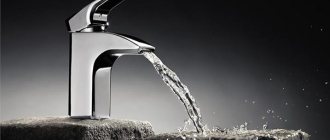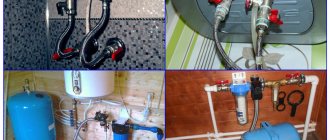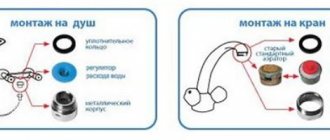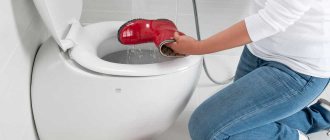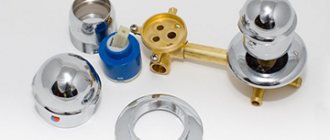How touch faucets work
In appearance, the sensor faucet can be distinguished from its other counterparts by the absence of unnecessary parts. The design consists of one spout, without valves, levers, handles or other devices for regulating the water supply. The main difference between this device is the photocell and infrared sensor mounted in the body.
The sensor’s task is to detect movement in the signal recognition zone within 30 cm. The sensitivity zone is adjusted automatically or manually.
Manual adjustment independently determines the degree of required proximity to the tap. An additional option determines the time interval after which water is supplied from the tap and when it stops flowing (up to several seconds from the moment the start/stop of movement is detected).
Not only the feeding time and the sensitivity zone can be adjusted. Additionally, using the side lever, the required temperature or mode of mixing the proportions of hot and cold water is adjusted. There is no need to adjust the temperature every time you open the tap; the stream is supplied in a constant, strictly specified mode.
The touch sensor has another advantage. It only reacts to movement. If soap, a towel or other object falls in the sensitivity zone, water begins to flow and continues to flow until the sensor detects the presence of movement. As soon as the fallen object stops making any movements, the flow of the jet stops.
Operating principle and design of a contactless faucet
The retail chain sells several types of mixers with automatic water supply control, differing from each other in their operating principles; they can be divided into the following categories:
With infrared sensor . An infrared sensor faucet is designed to automatically turn on the water when it detects thermal radiation in the range of its sensor, this can be hands or any object that has a higher temperature than room temperature. Typically, the range at which the sensor detects thermal radiation is adjustable; its standard value does not exceed 30 cm.
A typical touchless faucet with touch control has a pyroelectric element located in the front of the body under the spout. Infrared rays hit it through a focusing lens. An electrical pulse from the sensor, amplified by an electronic circuit, is supplied to an electromagnet coil with a valve on the armature. The valve opens the channel for the passage of water and closes it after a certain time after the hands are not in the range of action of the hand sensor - usually this interval is about 0.5 s.
To power the electronic circuit and the solenoid valve of the touch mixer, AA batteries or an AC-to-DC mains converter are used. The temperature of the water in the mixer is adjusted using a side tap on its body; the second option is via valves on the pipes under the sink.
With optoelectronic sensor . Any optical sensor consists of two elements - an emitter that forms a light beam, and a receiver that captures the light flux from the outgoing radiation. The beam can travel a certain distance from the radiation source to the photodetector if they are separated, or arrive at the sensor after reflection from any objects, when the receiver and emitter are located next to each other in the same housing.
The optoelectronic mixer implements the latest option for placing a sensor, the photocell of which receives a light beam after reflection from the surface of various objects. Light radiation can be located both in the visible part of the spectrum and in the invisible infrared region; the latter option is used more often in optoelectronic systems.
The standard location of the sensor is below the spout in the front part of the body; in some models it is installed separately from the mixer on a special panel. Mixing plumbing fixtures with optoelectronics are not so often found on sale; presumably, some models of the Oras and Ksitex brands, which have two windows on the front of the case, are equipped with optical sensors.
With touch sensor. In faucets of this type, there are pads on the body or spout, upon contact with which (Touch function) a charge is displaced on the metal surface. The change is detected by an electronic circuit and converted into current supplied to the valve solenoid coil. When voltage is applied to its winding, a rod with an elastic shut-off piston moves inside the coil, and the tap turns the water on or off.
Some sensor models have a function to turn on only cold water - they are not designed to work with a mixer. Touch taps are powered, like other models, from an AC-DC converter of 6 - 9 V or AA batteries with a total voltage of 6 V.
With induction sensor . Many not only Internet resources, but also the authors of factory manuals and operating instructions, indicate the presence of induction sensors in the design of cranes that respond to movement within their range of action. They suggest that the presence of body parts in the area of magnetic force lines can affect the electromagnetic field, the change of which is detected by the sensor.
These arguments contradict physical laws that state that the appearance of only a metal object in the area of force fields of the magnetic circuit of the inductor can affect the change in magnetic conductivity. In this case, a decrease in the magnetic resistance of the core and, accordingly, an increase in the inductance of the coil included in the electrical circuit of the generator will affect its frequency. Next, the new frequency of the generator is recorded and processed by an electronic circuit that creates control pulses.
Theoretically, a non-contact mixer may contain not an inductive (inductive) sensor that reacts to approaching metals, but a capacitive one. In capacitance meters, the sensitive element is one of the plates of a spatial capacitor (for example, a spout), the second can be the ground or the body of a metal sink. Between the two plates of the capacitor in the normal state there is air, the dielectric constant of which, due to its low density, is close to unity (1 is the indicator in a vacuum), and the capacitance of the spatial capacitor is correspondingly small.
When any object with a dielectric constant different (greater) from air appears between the plates, the electrical parameters (capacitance) of the capacitor change (increase) in the generator connected to it, which affects its frequency. Changes are recorded by an electronic circuit that creates a current that controls electromechanical devices. The problem with capacitive sensors is that after turning on the water, it is unlikely that they can be turned off with your hands - the dielectric constant of water of about 80 units is comparable to the permeability of a person of 40 - 60 units.
Device of touch mixers
Like any technological item, this model requires power supply via batteries. The battery charge lasts up to 2 years of active use in public places (up to 5 thousand automatic starts per month). At home, the battery charge will last much longer, so you don’t have to worry about replacing batteries.
The faucet kit with touch sensor includes:
- the electronic unit;
- batteries;
- spout;
- valve;
- temperature adjustment levers;
- connecting hose;
- filter.
Many of the models are equipped with a remote control to make settings for the device remotely.
The design of the model includes the presence of an induction sensor that creates a magnetic field. The entry of a foreign object into it serves as a signal to the control unit responsible for supply/shutdown.
The supply is provided by a special solenoid valve. This valve contains the following components:
- solenoid coil;
- shielding coil;
- core tube;
- membrane;
- saddle;
- compaction;
- housing with lid;
- spring;
- core;
- retainer;
- tip.
The water is opened by lifting the core with the membrane. Electrical voltage is supplied to the zone of the electromagnetic field that affects the core. The check valve protects against backflow.
Mixers with piezo element
The rarest category of automatic faucets. Instead of an induction sensor there is a piezoelectric element. Looks like a smooth chrome surface.
By pressing on the body, a person displaces the crystals underneath, and their friction against each other produces a weak electrical signal, as when rubbing amber on wool. Then everything is the same as in an induction tap. Such products are used where increased resistance to vandalism is needed: in prisons, psychiatric hospitals, and in aggressive environments.
Kinds
- Depending on the purpose of the devices, they are divided into kitchen models (with a swivel or U-shaped spout), models for urinals (built-in, external), and models for toilets (automatically adjusted to flush).
- By appearance (models with push-button sensors, display, non-contact, with built-in lamp).
- According to the length of the supplied jet (more than 35 cm long, medium, short, with a rotating mechanism, fixed).
- According to the principle of operation (spout from separate taps, single lever, electronic, double spout).
Content
Resistive touch screen
Infrared touch screen
Capacitive touch screen
Pressure-sensitive touch screens - 3D Touch
Wave touch screens
Instead of a conclusion
Before touchscreens, the most common interface for entering commands into electronic devices was various keyboards. Although they seem to have nothing in common with touchscreens, in fact, how similar a touchscreen is to a keyboard can be surprising. Let's look at their device in detail.
The keyboard is a printed circuit board on which several rows of switches-buttons are installed. Regardless of their design, membrane or mechanical, when you press each of the keys, the same thing happens. An electrical circuit is closed on the computer board under the button, the computer registers the passage of current in this place of the circuit, “understands” which key is pressed and executes the corresponding command. In the case of a touch screen, almost the same thing happens.
There are about a dozen different types of touch screens, but most of these models are either outdated and not used, or are experimental and are unlikely to ever appear in production devices. First of all, I will talk about the structure of current technologies, those that you constantly interact with or at least may encounter in everyday life.
Pros and cons of touch faucets
Advantages of touch mixers This model has many positive characteristics - from convenient use to wide areas of application, reliability and manufacturability.
- Practicality. The sensor faucet is indispensable when arranging public places. Nightclubs, cafes and restaurants, health and entertainment centers, educational and medical institutions are equipped with such models. The increased interest in these devices is quite justified. With repeated active use, valves and levers failed, required replacement of parts, and led to idle plumbing fixtures. When switching to touch sensors, the need to repeatedly rotate valves, adjust the required temperature conditions has disappeared, and unreasonable waste of water during a leak of a faulty faucet is eliminated. Conventional devices are inferior to touch devices in terms of wear resistance and safety.
- Hygiene. The need to rotate valves and levers to supply the jet forces people to touch them with their hands. Dirty hands leave germs and bacteria on the surface of valves and levers. Subsequent users of water are forced to touch contaminated valves and transfer infections and pathogens further. Constant treatment with disinfectants will not give results - after all, you will have to constantly wipe with a disinfectant solution. In models with a touch water supply sensor, you do not need to touch the faucet surfaces. This means that the risk of infection or transfer of foreign microbes is minimal. This feature was appreciated and began to be used in places where disinfection is especially important - children's institutions.
- Rational use of water. Touch models are also supported by the fact that there is no need to monitor how tightly the tap is closed, whether the threads are broken, or whether there are leaks. Saving water consumption will significantly reduce the costs of public catering establishments. Cafe visitors may forget to turn off the tap or not bother doing so at all. It is impossible to control the degree to which the tap is closed for each visitor to the restroom. And it’s not necessary - the sensor will do it.
- Safety at home. When leaving for the whole day, the apartment owner does not worry whether the tap is closed or whether there is a risk of flooding the neighbors due to a faulty faucet.
- Convenient operation. Setting the water temperature is done once. There is no need to additionally adjust the hot and cold water supply pressure to set the desired temperature. The device will automatically adjust the temperature on its own.
- Aesthetic appearance. The design of this design is elegant and lightweight, which allows it to be used in various interior designs.
Disadvantages of touch faucets Despite its external beauty and practicality, this model is not suitable for arranging kitchen sinks. Installation of a sensor model involves supplying water at a relatively constant temperature.
In the kitchen, it is often necessary to change the degree of heating - for washing dishes, the water should be warm or hot, for washing fruits and vegetables - colder, sometimes you need to quickly cool a particular product, or vice versa, warm it up.
Housewives also need to regulate the power supply. The optimal choice in the kitchen is a conventional single-lever device - the water is easily opened and adjusted with one movement of the hand.
Sometimes you need to use a sink to fill it with water. Under normal conditions, for these purposes, the sink is plugged with a stopper and water is supplied. In order for the sensor to allow water to collect, you will have to constantly move your hands so that the water continues to flow to the required level. Quite an inconvenient way to fill the sink.
For the same reason, the touch sensor will not allow you to fill the bathtub or pour water into the basin. You will need to turn off the sensor once, apply pressure, and turn it on again after filling. There is no need for such labor-intensive use of the sensor. It is easier to install a model with a conventional spout (single-lever or valve mixer).
Thus, the functionality of the sensor device limits the scope of application - either for installation on washbasins, in the toilet at home, or as washbasins in public areas.
Advantages
- Economical . One of the main advantages of a touch mixer is its cost-effectiveness. Automatic shut-off of the water supply eliminates its irrational use. Consequently, it reduces financial costs for water supply services.
- Environmental friendliness . The sensor faucet helps you save not only time and money. In recent decades, the rational use of natural resources has become the number one problem on a global scale. And automatic faucets can be classified as innovative technologies that help rationally use the planet’s water resources.
- Maximum hygiene . It was this advantage of automatic taps that was first appreciated by the owners and users of public bathrooms. Using a contactless faucet does not involve contact between the device and a person. This means that the mixer does not become a breeding ground for bacteria and a source of infection. Which is a huge advantage for public places, catering establishments, children's and medical institutions. There is no need to constantly disinfect your plumbing fixtures.
- Durability . The design of the mixer does not imply the presence of moving valves and control levers. Namely, these parts fail most quickly in conventional mixers. Especially during intensive use. Therefore, this advantage of sensory mixers is again especially appreciated by owners of public premises. But for a home, the durability parameter is by no means the least important advantage.
- Flood protection . Now you don’t have to worry about whether you turned off the tap before leaving home. The “smart” mixer closed it behind you. And you definitely won’t flood your neighbors below.
- Extra comfort . The sensor faucet already “knows” what water temperature you like and what pressure you need. That is, as a faithful servant, taking into account all your needs and wishes, he will serve you at the highest level. And this, you see, is just nice, in the end.
Installation
Installation of the sensor mixer is done in two stages. 1st stage. The body part is installed. 2nd stage. The device is connected to the water supply. The water supply must be shut off before installation.
The housing is installed in a place prepared for this purpose - a hole in the sink. If an old mixer was used before, it must first be dismantled. A round mounting gasket must be placed between the sink and the tap. The lower part of the device is attached to a gasket or plate, then secured with a nut.
All necessary mounting materials are included with the device.
The control box is secured using 4 additional bolts. It is placed at a distance of at least 50 cm (on average about 55 cm) from the floor. The mixer is connected to the control box with a flexible hose with the obligatory placement of a gasket.
The device is connected to the water supply system using nipples. The hot water tube is connected to the nipple marked in red, the cold water tube is connected to the nipple marked in blue.
Correct operation of the solenoid valve is ensured by a sensor wire connected via a connecting nut to the control box. To install the batteries, unscrew 4 bolts and remove the cover. After placing the batteries, the cover is fixed back.
After installation work is completed, the water supply is connected and the operation of the tap is checked. To do this, you need to bring your hands into the sensitivity zone of the photocell and check whether water flows. Next, the work is adjusted - the time interval before/after the end of water supply, temperature conditions, sensor sensitivity areas.
Styluses
A characteristic feature of devices with a resistive sensor is the widespread use of a stylus, the contact area of which with the surface is smaller than that of a finger, and the pressure force is greater, which results in more accurate input.
The presence of a stylus is desirable, although not necessary for screens with a small diagonal (mainly phones, and a few years ago, PDAs), however, in tablets, sufficient accuracy can be achieved using your fingers.
After PDAs were completely replaced by smartphones and other devices several years ago, it seemed that styluses had left the scene along with them forever, but now you can increasingly see their reincarnation, especially in devices of intermediate sizes between smartphones and tablets.
Since resistive screens are used less and less now, styluses have also changed a bit. Adapting to modern realities, they began to be produced with special attachments at the end, which are recognized by capacitive screens.
Problems
If the sensor breaks down, it is not recommended to repair it yourself. In this case, it is better to contact a professional.
More often, users of a sensor faucet encounter clogging of the aerator. A sign of clogging is a reduced jet pressure.
To fix the problem, you need to remove the rusty aerator and replace it with a new one.
Flaws
Any contamination at the edges of the matrix, obscuring infrared signal sources, leads to malfunctions of the sensors. Problems also arise with slight curvature of the device, when the rays leave a plane parallel to the screen.
However, one of the most common problems with infrared sensors is false alarms. Since users do not have to physically touch the screen, sometimes the sensors are activated when the finger is sufficiently close to the screen or while it moves from one point to another.
Despite the fact that infrared sensors are often used in devices with a relatively low cost (for example, e-readers), screens with an infrared sensor themselves are more expensive than both resistive and capacitive screens.
How to choose
The first thing people pay attention to is whether the mixer is really touch sensitive. On the plumbing equipment market, there are similar models of conventional taps with a sensor for stopping and starting the water supply.
Unlike a faucet, the water in a regular tap is not mixed - it flows either hot or cold and is only suitable for a single-pipe water supply system. In addition, there are two mounting holes for two taps in the sink.
The second point that is taken into account when purchasing is for what purposes the mixer is intended to be used. You should not buy it for installation on the kitchen sink or for the bathtub. All the strengths and advantages of the faucet lie in its operation on washbasins (washing hands, washing, etc.) with frequent use in one constant temperature mode, with the same water supply pressure.
Such a faucet is a godsend for restrooms in public places - cafes and restaurants, gyms, various children's centers, entertainment, educational or medical institutions.
This application option will really reduce water consumption, the cost of repairing plumbing equipment, eliminate the risk of leaks, and reduce the chances of infection through touching common valves.
Since this device belongs to technological equipment that works on the principle of a “smart home” system, the budget for its purchase is higher than for a regular mixer. This is taken into account when choosing a particular model.
When selecting a sensor device, attention is also paid to the design of the room, the ability to combine style with other interior elements - color, shape, material.
Thanks to the wide range of models, choosing the best option will not be difficult. Advertising from sponsors: // // //
